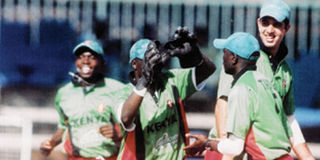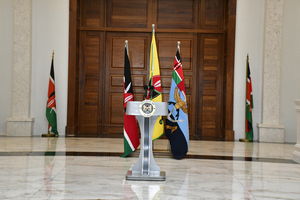How tiny Kenya gatecrashed elite world of cricket gods

PHOTO | FILE Kenya skipper Steve Tikolo (right) celebrates with team mates after taking the wicket of Srinath Jayasuriya of Sri Lanka during the 2003 Cricket World Cup at the Nairobi Gymkhana.
What you need to know:
- The mood in the air was a sign of things to come — that Kenya would triumph — even as Sri Lanka won the toss and decided to field
- The delirious fans went wild as the local cricketers took laps of honour around Nairobi Gymkhana, the grounds where they had proved to the cricket world that they were no pushovers
- Even though Kenya lost West Indies they had done enough to qualify for the Super Six stage, becoming the first non-test nation to progress beyond the first round of the World Cup
Nairobi Gymkhana was the place to be at on February 24, 2003. Security was tight, but the grounds were teeming with cricket fans while at the 30-metre high media centre, drinks were flowing like water, courtesy of Kenya Breweries and Pepsi, the proud sponsors of Kenya and Pakistan national cricket teams respectively.
Pakistan was not anywhere near, but the visiting team was Sri Lanka, the 1996 World Cup champions which, unlike New Zealand had defied “insecurity” fears and agreed to play Kenya at home in the 2003 Cricket World Cup that was principally hosted by South Africa, with some matches in Kenya and Zimbabwe.
The mood in the air was a sign of things to come — that Kenya would triumph — even as Sri Lanka won the toss and decided to field, and within the first minute, Ravindu Shah was given out to leave Kenya a wicket down with only one run on the board.
Chaminda Vaas took the wicket of Shah with his second ball and added Brijal Patel soon afterwards, before Kennedy Obuya hit 10 boundaries in his fiery knock.
The introduction of Sri Lanka’s star bowler, Muttiah Muralitharan, into the bowling attack, saw Kenya’s run rate drop dramatically after he removed captain Steve Tikolo (leg before wicket), his first victim in a spell of four for 28 runs.
He then clean bowled Hitesh Modi, after which he had Maurice Odumbe caught by RP Arnold and then clean-bowled Tony Suji.
Vaas added his third wicket in his second spell before a quick-fire 20 runs from Peter Ongondo took the hosts past the 200-run mark to end with 210 for the loss of nine wickets in 50 overs.
Buoyed by the performance, Kenya was out to prove a point and even though Marvan Atapattu started confidently with two boundaries from the first over, the hosts’ spirits were not dampened.
Delirious fans
The Sri Lankan captain, Sanath Jayasuriya, who was a star of the 1996 World Cup, was the first to go, caught by Brijal Patel off Martin Suji after scoring only three runs from seven deliveries.
They were only 13 runs on the board. Atapattu was the second wicket the visitors lost after he was bowled by current assistant coach Thomas Odoyo.
He was followed back to the pavilion by Hashan Tillakaratne who was caught by Tony Suji off the current captain, Collins Obuya, after scoring a 47-ball 23.
Next to fall was Mahela Jayawardene (caught and bowled by Collins Obuya), followed by Kumar Sangakarra (caught by Kennedy Obuya off Collins), the 1996 captain Aravinda de Silva (caught by Kennedy Obuya off Collins), Chaminda Vaas (caught and bowled by Collins), Prabath Nissanka (caught by Thomas Odoyo off Stephen Tikolo), Muttiah Muralitharan (caught by Tony Suji of Tikolo) and CD Fernando who faced eight balls and scored seven runs which included one boundary. He was bowled out by Maurice Odumbe.
With the wicket of Fernando, Sri Lankans were all out for 157 from 44.5 overs and lost the match by 53 runs.
The delirious fans went wild as the local cricketers took laps of honour around Nairobi Gymkhana, the grounds where they had proved to the cricket world that they were no pushovers.
“We were confident of beating the Sri Lankans as we were playing our first match of the World Cup before our home fans,” a happy captain, Tikolo said, while the Sri Lankan captain, Jayasuriya refused to admit that Kenya was a better side, and instead said that “we were not playing like professionals, we played like amateurs.”
Great feeling
Kenya would have cared less. They went back to South Africa where they downed Bangladesh. Even though Kenya lost West Indies they had done enough to qualify for the Super Six stage, becoming the first non-test nation to progress beyond the first round of the World Cup.
And they went further. Kenya recorded a famous seven wicket victory over fellow Africans Zimbabwe to become the first non-test nation to qualify for the World Cup semifinals.
Thomas Odoyo struck a powerful 43 off 40 balls with eight fours as Kenya easily reached its meagre victory target of 134 from exactly 26 overs in the Super Six match. He shared an unbeaten partnership of 73 with Maurice Odumbe (38 not out).
“Our target was the Super Sixes but then we reviewed our target,” said Tikolo, the captain at that World Cup. “We just decided to go out and be positive,” Odumbe added. “Normally low scores are very tricky so we just decided if there was a ball to hit we would hit it. “It’s a great feeling and I’m sure people back home are happy.”
In the 1996 World Cup, Sri Lanka may have set a record with the Kenyan team in Kandy, but the carnival mood at Nairobi Gymkhana on February 24, 2003 was a sign that Kenya was out to upset the Test-playing side with all its stars.
After Kenya had brought down the soaring West Indies by 73 runs in Pune in Match 20 of the 1996 Cricket World Cup, their new-found Indian fans could not forget Maurice Odumbe, the then skipper who managed only six runs from 30 deliveries.
Odumbe was given out after 48 minutes on the crease after he hit his wicket when he tried a reverse sweep off an Ian Bishop delivery.
Kenya then faced Sri Lanka, at home in Kandy where the hosts scored a record-setting 398 for five, a record which was broken in 2006, at Wanderers Stadium, Johannesburg, in a match between Australia (434 for 4 off their 50 overs) and South Africa, which scored 438 for 9, and won by one wicket with one ball to spare.
That 1996 win against West Indies might have been a small step for the cricket world, but it was a big step for Kenya, for, this was not only first ever win for Kenya in official ODIs and they had beaten their heroes, idols, the people they had always wanted to be and to play like.
“We were expecting to beat a side like Zimbabwe,” says Thomas Odoyo, who was then a 17-year-old bowler. He scored 24 runs and left the World Cup 45,000 rupees richer.
Made matters worse
He says that apart from planning to beat Zimbabwe, there was a consensus that the players were to put a good performance, and the aim was getting contracts to play county cricket in England.
“We did not expect to beat West Indies because they were the best side then,” he says, adding that there was disbelief in the dressing room.
The win introduced Kenyan cricket to the world, and gave the then Kenya Cricket Association the impetus to expose the boys to more international matches.
The following years saw more “A” teams from cricket nations coming to Kenya. To make matters better, club cricket was also strong, and Indian cricket heavyweights like Sanjay Manjrekar and Sandeep Patil (who became Kenya’s most successful coach and took the team to the 2003 World Cup semi-finals) were common faces in local cricket grounds.
Kenya’s chance to attend another World Cup came in 1999 in England. They were an Associate member known as a side that could spring a surprise and embarrass even the best sides. But the performance was nothing but lacklustre and Kenya lost all its group matches even though 1996’s flamboyant skipper, Maurice Odumbe earned his second Man of the Match Award in a World Cup.
Great potential
He would repeat this feat in 2003 to become the only Kenyan to win a Man-of-the-Match Award in three successive World Cups.
The losses of 1999 seemed to have been a wake up call for the Kenyan team and the administration that realised there was potential which needed to be exploited.
It threw its weight behind the boys, and for a moment, Kenya became the preferred destination for cricket lords, what with provincial sides and “A” teams of the big cricket nations coming to play in Kenya as if the International Cricket council was awarding brownie points to cricketers who landed on our shores.
Local companies were not left behind either, and they were ready to give the required support. Money was not a problem for the cricketers who were not only getting allowances, but were receiving monthly salaries too, whether they played or not.
You can actually say that local cricketers became the first Kenyan sportsmen to earn monthly salaries — and it was much more than the 45,000 rupees that Odoyo earned for participating in the 1996 Cricket World Cup. The cricket world was changing, and more and more companies were realising the potential of cricket, and were “investing” in it.
Local companies did not want to be left behind, thanks to the industriousness of the strong marketing team of Kenya Cricket Association which wanted to bring the local players to the levels of their bigger counterparts whose federations’ budgets ran into hundreds of millions of dollars.
In 2000, Kenya became the venue for the ICC Knockout Trophy, a mini World Cup which saw all the Test sides pitching tents in Nairobi and taking time during rest days to visit the game parks, wildlife sanctuaries and the pristine beaches. Cricket in Kenya had come of age.




